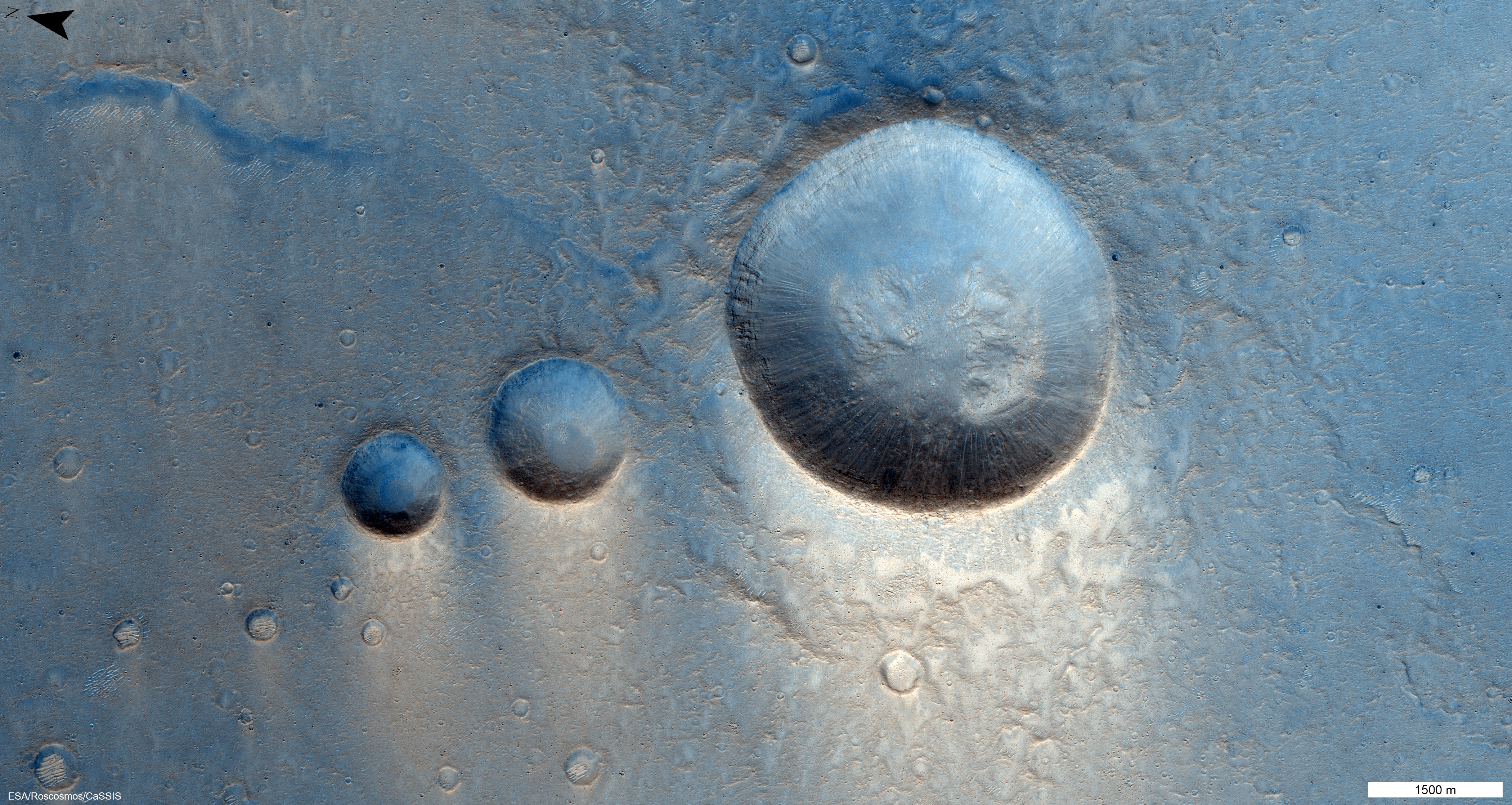ExoMars-CaSSIS

Trio of craters on Mars as imaged by CaSSIS instrument on the TGO. ESA/Roscosmos/CaSSIS
The ExoMars Programme
The ExoMars programme is a joint endeavour between the European Space Agency (ESA) and Russian Space Agency (Roscosmos) to explore the atmosphere and surface of Mars. The first step of the programme launched the Trace Gas Orbiter (TGO) and the Schiaparelli EDM lander. Unfortunately, the lander did not land successfully and crashed into the Martian surface. The TGO, however, was successfully injected into an orbit around Mars. On board the orbiter are several scientific instruments, one of which is the Colour and Stereo Surface Imaging System (CaSSIS). Step two in the programme focuses on a surface mission, which includes the Rosalind Franklin rover.
Goals of the ExoMars programme include:
- Searching for past or present life on Mars
- Characterizing water and various geochemical environments on and directly beneath the surface of the planet
- Learning more about the subsurface of Mars to better understand its history and habitability
The TGO
ExoMars-TGO launched on 14 March 2016 and entered Mars orbit 19 October 2016. Over a period of 18 months, TGO was maneuvered into a specific orbit around the planet, which is required to conduct science, and was reached on April 9, 2018.
Main goals of the ExoMars-TGO:
- Investigate geological or potential biological origin of trace gases on Mars
- Deliver the Schiaparelli lander (it later crashed)
- Serve as a data relay for the lander on the surface (did not achieve as the rover crashed)
CaSSIS
CaSSIS is an instrument on board the TGO in orbiter and its goals are to:
- Investigate potential surface and subsurface sources of methane and other trace gases
- Investigate dynamic surface processes that may contribute to atmospheric gases
- Characterise potential future landing sites (for the Rosalind Franklin rover)
CaSSIS Team
Most contributors are based in Europe, however Livio Tornabene at Western is one of 24 co-investigators on CaSSIS science team. He remains the only Canadian-based member supported and funded by the Canadian Space Agency (CSA) for the past 9 years, with funding covering the extended science phase of the mission until 2025.
Official CaSSIS Associates (additional team members of CaSSIS appointed by a Co-I and approved by the Instrument PI Nicolas Thomas, University of Bern, Switzerland):
Collaborators:
Students:
Industry Partners:
Science being conducted by Western
The CaSSIS team at Western is focusing on several areas of research with the CASSIS instrument.
Impact Cratering
Craters formed from impacting objects can shed light on multiple geological planetary processes on Mars and even past climate conditions. While impacts are known for their destructive forces, they are also capable of recording and preserving characteristics of the planet at the time of impact. As such, we are able to learn more about what Mars was like in the past by studying its impact cratering record.
Volatile compounds trapped in the subsurface are released during impact events. These gases may have affected atmospheric conditions of Mars in the past, and even contributed to potential variations in the habitability of the planet. Craters may have provided habitats for life and even changed potential water presence on the surface.
Clay Composition
Clay-bearing rocks on Earth are usually formed in the presence of water. While the discovery of similar clays on Mars suggests that the climate may have been warmer and wetter in the past, clays have also been observed in meteorites and their parent asteroids. This is an important and overlooked observation by the science community as these bodies never possessed surface water or atmospheres. This strongly suggests that clays can form in the Solar System by other means that is beyond what is most common on Earth. This makes the assertion that the presence of clays on Mars may not be evidence of a “warm and wet” early Mars. Dr. Tornabene has researched the correlation between heavily-cratered regions with the presence of many of these clay rocks. As it tuns out, clays are commonly associated with impact craters on Earth, where remnant heat and water – released by the impact – form clays and other hydrous minerals. This suggests that trapped ice beneath the surface of a mostly cold and dry Mars could be released to form clays and other hydrous minerals during and after an impact event. Using CaSSIS data, Dr. Tornabene will continue to investigate the hypothesis that impacts may have generated hydrous minerals, including clays, as a consequence of impact cratering. Because this suggests a “warm and wet” climate is no needed to form these minerals, it will help shed light on the past climate and habitability of Mars.
Progress to Date
Over 20 members of the institute have contributed and at least 18 have had their first experience with planetary missions with this project. The collection and sharing of collected images have also benefited the wider science community. This project has resulted in 20 publications, 5 graduate student theses, as well as 25+ media interactions and interviews!

